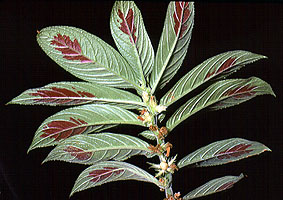
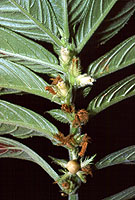
Cult. BG Vienna, phot. A. Weber (1979)
= Columnea sect. Collandra (Lem.) Benth. (see Kvist & Skog 1993).
Full name and orig. publication: Dalbergaria Tussac, Fl. Antill. 1: 141, pl. 19 (1808-1813).
Etymology: Named for Karl Theodor von Dalberg (1744-1817), grand duke of Frankfurt and archbishop and elector of Mainz, Germany
Synonyms: Collandra Lem. (1847), Columnea L. sect. Collandra (Lem.) Benth. (1876), Columnea L. subg. Collandra (Lem.) Hanst. (1865).
Infrafamilial position: Gesnerioid Gesneriaceae (Gesnerioideae) - Episcieae.
Description: Epiphytic suffruticose plants with strongly anisophyllous shoots, recalling to some extent fern-fronds. Leaves subsessile, in close-set, nearly distichous pairs; the large leaf oblanceolate or elliptic, the small leaf stipule-like; underside of the lamina often marked with species-specific red patterns. Axillary cymes few-flowered hidden from above. Corolla tubular, with a narrow subregular limb or somewhat inflated and with a bilabiate limb, rarely like in Columnea s.str.. Nectary of two large, connate dorsal glands, sometimes with an additional small ventral gland. Ovary superior. Fruit an ovoid, usually coloured berry.
Chromosome number: 2n = 18.
Species number: Over 90.
Species names (incl. publication and synonyms): See Skog, L.E. & J.K. Boggan. 2005: World checklist of Gesneriaceae: http://persoon.si.edu/Gesneriaceae/Checklist.
Type species: D. phoenicea Tussac = D. sanguinea (Pers.) Steud.
Distribution: Bolivia to the Guayana Highlands, north to Mexico, Greater Antilles;
Ecology: Growing epiphytically in lowland and (more frequently) montane rain forests.
Notes: Dalbergaria is different from the other columneoid taxa by (a) the strongly anisophyllous shoot structure, (b) the ovoid and usually coloured berry. The pollen grains are suboblate to prolate spheroidal, with considerable differentiations around the colpi. Pollination is by hummingbirds. As the flowers are mostly hidden under the close-set leaves and inconspicuous (with yellow or white colour), attraction is apparently mainly the red or purple markings or red translucent windows on the leaves (see Jones & Rich 1978, as Columnea).
Selected references: Jones & Rich, Bull. South Calif. Acad. Sci. 71: 113-116 (1972), poll.; Wiehler, Selbyana 6: 189 (1983); Kvist & Skog, Allertonia 6: 327-400 (1993), reg. rev. (Ecuador).
Bibliography: See Skog, L.E. & J.K. Boggan. 2005. Bibliography of the Gesneriaceae. 2nd edition: http://persoon.si.edu/Gesneriaceae/Bibliography.
Illustrations:

|

|
Dalbergaria sanguinea
(Pers.) Steud. = Columnea sanguinea
(Pers.) Hanst. (= D. phoenicea
Tussac, type)
Cult. BG Vienna, phot. A. Weber (1979) |
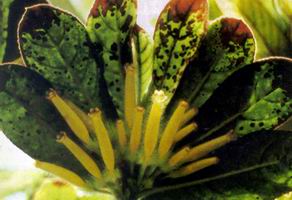
|
Dalbergaria cruenta
(Morley) Wiehler = Columnea cruenta
Morley
Gloxinian 36(3), (1986) |
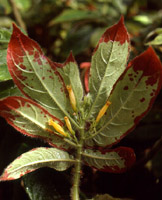 |
Dalbergaria
perpulchra (C.V.Morton) Wiehler = Columnea perpulchra C.V.Morton
Cult. Marie Selby BG, phot. A. Weber (1982) |
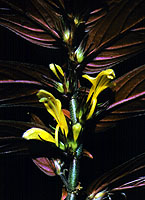
|
Dalbergaria
verecunda (Morton) Wiehler = Columnea verecunda Morton
Cult. BG Vienna, phot. A. Weber (1980) |
last modified: 2007-01-05